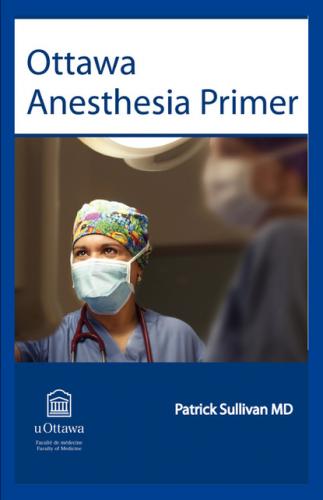Ottawa Anesthesia Primer. Patrick Sullivan
Collaborator, and Manager. Students are encouraged to conduct themselves professionally, to become involved and collaborate with the anesthesia surgical team, to communicate effectively with patients and the surgical team, and to advocate on behalf of the patient. Students should strive to develop a scholarly understanding of the subject matter by reading the required material and by asking questions during their anesthesia rotation. Above all, we must always remember that our primary goal is to provide safe and compassionate care for the patient.
While students may view anesthesia as a specialty with limited patient contact, they should ensure that opportunities for communication with the patient and family do not pass by. Fact gathering encounters do not have to be devoid of reassurance, kindness, or a comforting touch. We expect both positive and negative experiences during the anesthesia rotation to be discussed openly with us to ensure the best possible rotation for both current and future students.
Fig. 1.1 The six roles of the medical expert as identified by the CanMEDS Physician Competency Framework.
General Objectives
Knowledge and Skills:
1 To demonstrate an understanding of the anesthetic considerations for a variety of medical conditions and perform the appropriate preoperative assessment and preparation of the patient.
2 To acquire the knowledge necessary to conduct appropriate fluid and blood component therapy.
3 To recognize and describe the main drug classes frequently used in the perioperative period.
4 To acquire knowledge for the safe provision of local anesthesia appropriate for general medical care.
5 To review and describe the principles of acute pain management.
6 To acquire basic skills in airway management.
7 To participate in an emergency resuscitation and, in so doing, to recognize the various roles that health care professionals play in such situations, as assessed by the student’s preceptor during a real or simulated emergency.
SPECIFIC KNOWLEDGE AND SKILLS OBJECTIVES (expanded from general objectives)
1. To demonstrate an understanding of the anesthetic considerations for a variety of medical conditions and perform the appropriate preoperative assessment and preparation of the patient.
By the end of the rotation, the medical student will be able to:
a. Obtain and record a pertinent medical history.
b. Perform a focused physical examination, including assessment of the airway, the respiratory and cardiovascular systems, and other systems as indicated by the clinical situation.
c. Interpret basic laboratory data and investigations relevant to the preoperative assessment.
d. Develop a problem list and assign an appropriate American Society of Anesthesiologists’ (ASA) physical status based on their patient assessment.
e. Recommend appropriate preoperative medications (e.g., anxiolytics, aspiration prophylaxis) and recognize which medications to refrain from using preoperatively (e.g., anticoagulants, oral hypoglycemic agents).
f. State the recommended preoperative fasting guidelines, list the risk factors for perioperative aspiration, and describe strategies to reduce this risk.
2. To acquire the knowledge necessary to conduct appropriate fluid and blood component therapy.
By the end of the rotation, the medical student will be able to:
a. Recognize and describe the physiologic and pathologic routes of fluid losses and be able to estimate these losses.
b. Assess a patient’s volume status (i.e., volume of blood in a patient’s circulatory system) using history, physical examination, and laboratory investigations.
c. Successfully establish and secure intravenous access using sterile technique with catheters of various sizes.
d. Demonstrate an understanding of the composition of commonly available intravenous fluids by selecting appropriate perioperative fluid and electrolyte replacement while taking into account the patient’s deficits, maintenance requirements, and ongoing losses.
e. State the indications and complications of the various blood products, e.g., packed red blood cells (PRBCs), fresh frozen plasma (FFP), and platelets and describe the factors influencing one’s decision to administer blood product therapy.
3. To recognize and describe the main drug classes frequently used in the perioperative period.
By the end of the rotation, the medical student will be able to describe the main therapeutic effects, side effects, and contraindications of the following classes of medications:
a. Benzodiazepines (midazolam, lorazepam)
b. Opioids (fentanyl, morphine, hydromorphone, codeine, meperidine)
c. Induction agents (propofol)
d. Inhalational agents (desflurane, sevoflurane)
e. Local anesthetics (lidocaine, bupivacaine)
f. Muscle relaxants (succinylcholine, rocuronium)
g. Nonsteriodal anti-inflammatory drugs (NSAIDS; ibuprofen, naproxen, celecoxib)
h. Vasoactive medications (ephedrine, phenylephrine)
i. Antiemetics (dexamethasone, ondansetron, prochlorperazine, haloperidol)
4. To acquire knowledge for the safe provision of local anesthesia appropriate for general medical care.
By the end of the rotation, the medical student will be able to:
a. Differentiate the two classes of local anesthetics and state the maximum recommended doses for lidocaine and bupivacaine.
b. List common anesthetic drugs used for topical anesthesia, local infiltration, and peripheral nerve blocks.
c. Describe the signs and symptoms and management of local anesthetic toxicity, including inadvertent intravascular injection of local anesthetics and allergic reactions to local anesthetics.
5. To review and describe the principles of acute pain management
By the end of the rotation, the medical student will be able to:
a. Explain the concept of multimodal analgesia.
b. Identify and describe a variety of modalities commonly used for pain control. Examples of these include patient-controlled analgesia (intravenous PCA), intrathecal (spinal) opioids, epidural infusions, and peripheral nerve blockade.
6. To acquire basic skills in airway management
By the end of the rotation, the third-year medical student will be able to demonstrate the ability to manage the airway and ventilation of an unconscious patient.
This will be demonstrated by the ability to:
a. Label the basic structures of the oropharyngeal and laryngotracheal anatomy.
b. State the indications and complications of airway management by face mask, laryngeal mask, and intubation.
c. Identify the appropriate size of face masks, laryngeal masks, oral and nasal airways, laryngoscope blades, and endotracheal tubes.
d. Recognize upper airway obstruction and independently demonstrate appropriate use of face mask, oral and nasal airways, head positioning, jaw thrust, and chin lift maneuvers.
e. Independently demonstrate bag-mask ventilation of an unconscious patient.
